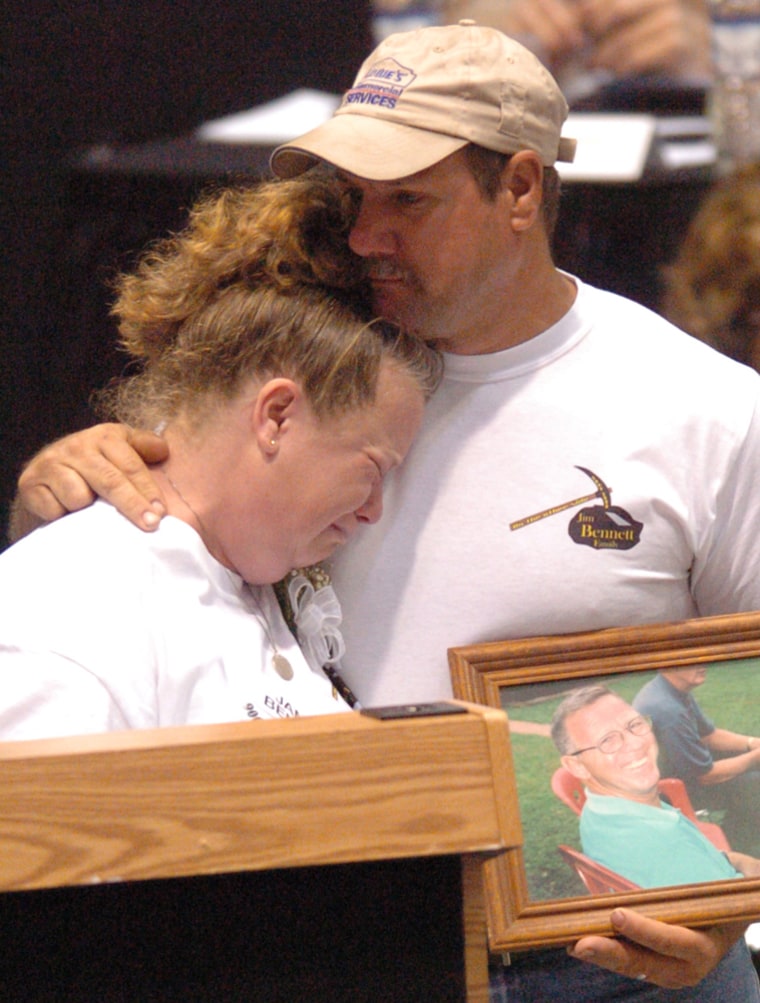“Did our dad have to die?” Peggy Cohen wanted to know Tuesday as mine safety regulators opened an emotional public hearing on questions still surrounding the January disaster that left 12 men dying deep inside the Sago Mine.
Wives and children of the other miners followed her to the microphone, some clutching framed photos of the victims.
“We assure you, Mr. Politicians, that we’re not going to let this rest,” said John Groves, whose brother Jerry Groves was among the victims. “We know in our hearts that this can be corrected. It needs to be done immediately, it needs to be done now. And it’s on you.
“If another accident happens without safety changes, you are responsible.”
Four months after the blast, officials from the federal Mine Safety and Health Administration, West Virginia’s Office of Miners’ Health Safety and the company that owns the Sago Mine began testifying about the disaster in a two-day public hearing.
Seeking answers about cause and response
The miners’ families wanted to know whether lightning caused the blast inside the mine that killed one of the crew. They also wanted to know why it took MSHA 11 hours to start the search for the trapped crew, and how the false news spread that 12 of the 13 trapped men were alive when all the men but one, Randal McCloy Jr., were dead.
McCloy wasn’t expected to testify at the hearing, but in a letter to the other miners’ families, he wrote that at least four of the air packs assigned to his crew failed to function, forcing the 12 men to share a limited supply of oxygen.
Mine owner International Coal Group Inc. said in a statement last week it had found no evidence the air packs malfunction. John Stemple, ICG’s assistant director of safety, told the hearing on Tuesday that the air packs may have failed because the trapped miners had been “overbreathing.”
“You have to slow your breathing right down. It’s not a unit that provides pressure,” he said.
The testimony Tuesday centered on the mine’s safety record in the year before the explosion and whether state and federal officials had appropriately enforced regulations.
Kevin Stricklin, MSHA’s district manager, defended the federal agency’s enforcement efforts and talked about how MSHA and mine owner International Coal Group had been working to make the mine safer since ICG took over.
“I do think the mine did seem to be improving in the fourth quarter of 2005,” Stricklin said. “It wasn’t a perfect mine, but we were working to make a better mine than what it was.”
State and federal investigators have not determined precisely what caused the explosion and were expected to press ICG officials on Wednesday to explain why it believes a powerful lightning strike triggered methane gas in a sealed off section of the mine.
Could disaster have been prevented?
One overriding question from the miners’ relatives, including Fred Ware’s daughter, Peggy Cohen: Was the explosion preventable?
The blast occurred as crews were preparing to resume production after the New Year’s holiday. Two miners entered the mine before the crews entered to check for problems.
One of them, fireboss Terry Helms, is believed to have died in the explosion. The second escaped, but has told federal and state investigators that his inspection report has been lost.
That doesn’t sit well with Debbie Hamner, widow of George Hamner and the families’ representative on the hearing panel. She said another miner recalls Helms reporting “two small violations, but he can’t remember what they were.”
“My husband’s dead, so there’s no small violations to me,” Hamner said. “This explosion, I believe, was preventable, and I don’t call this an accident. I call this a disaster.”
J. Davitt McAteer, a former MSHA director, is leading the hearing and the state investigation into the disaster. Gov. Joe Manchin has asked him for a report by July 1, along with recommendations on how to make coal mines safer, though McAteer said that deadline could be pushed back.
Rare for families to testify
McAteer said Tuesday that the families’ testimony in such a hearing was rare, but he said: “They have a right to expect that everything necessary will be done to improve mine health and safety conditions in the United States so that the Sago Mine disaster will be remembered as a turning point, as well as a tragedy.”
In the end, the families say the hearings are about those 12 men who “died doing what they were trained to do,” said Pam Campbell, whose brother-in-law Marty Bennett died in the mine.
“They tried to escape, and when they couldn’t escape, they went back where they knew they had air, and they barricaded themselves the way they were taught,” she said. “And as they shared rescuers amongst them, they beat on roof bolts and nobody listened. They waited for blasts from the surface, and those blasts never came.”
